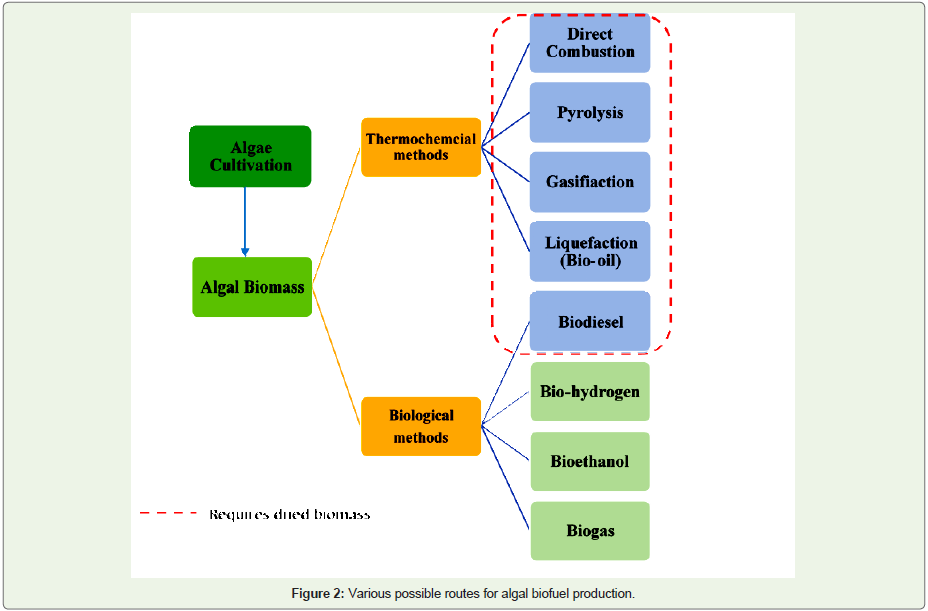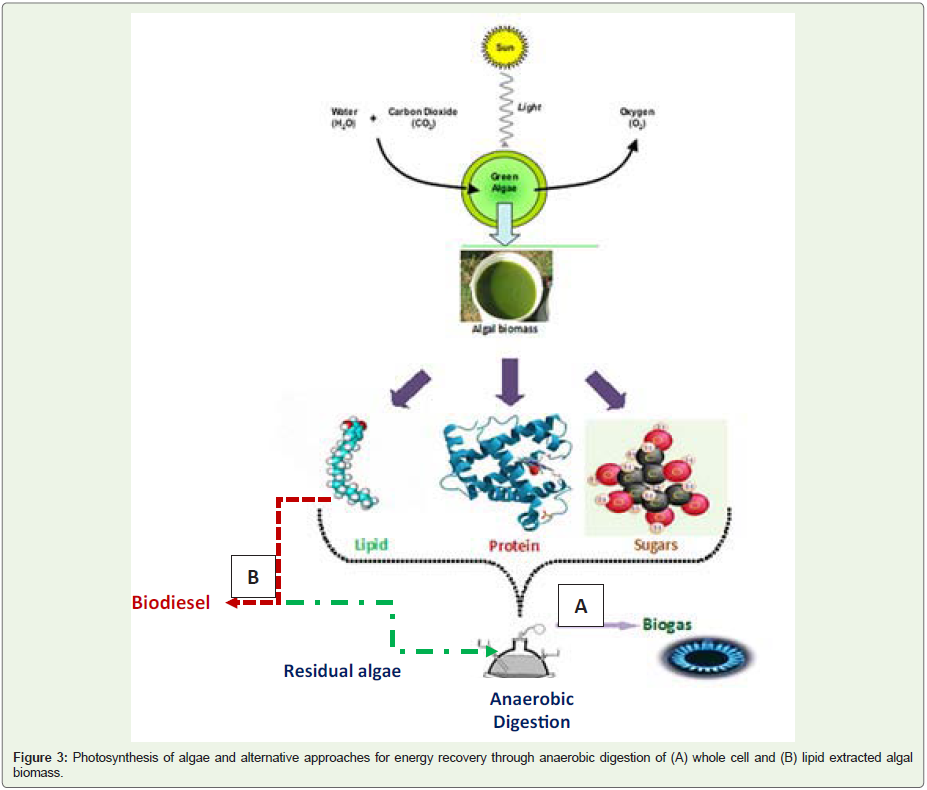Editorial
Algal Biomass as Feedstock for Biomethane Production: an Introduction
Sanjeev Kumar Prajapati1* and Anushree Malik2
1Biochemical Engineering and Bioenergy Laboratory (BEBL), Netaji Subhas Institute of Technology (University of Delhi), Sector 3, Dwarka, New Delhi (India) 110075
2Applied Microbiology Laboratory, Centre for Rural Development and Technology, Indian Institute of Technology, Delhi, Hauz Khas, New Delhi (India) - 110016
*Corresponding author: Sanjeev Kumar Prajapati, Biochemical Engineering and Bioenergy Laboratory (BEBL), Netaji Subhas Institute of Technology (University of Delhi), Sector 3, Dwarka, New Delhi -110075, Tel: 011-2500-0088, Email: sanjukec@gmail.com
Article Information: Submission: 23/12/2014; Accepted: 26/12/2014; Published: 02/01/2015
Copyright: © 2015 Sanjeev Kumar Prajapati, et al. This is an open access article distributed under the Creative Commons
Attribution License, which permits unrestricted use, distribution, and reproduction in any medium, provided the
original work is properly cited.
Editorial
More than half of the world’s population live in rural areas, out
of which around 90% (over 2 billion) is from developing countries
[1]. Energy and clean water are the two major concerns in the daily
life of rural people. Furthermore, rapidly increasing energy demand
and growing concern about environmental deterioration demands
encouragement of the use of renewable energy resources as alternate
fuels [2].
The current renewable energy resources such as solar, wind, hydro,
geothermal and biomass represent up to 14% of primary-energy
consumption in the world (Figure 1). Out of this, biomass (including
terrestrial and aquatic) based energy contributes approximately 53%
of the renewable energy consumption [3]. However, the biomass
based fuel may compete with the food and fodder crops. Unlike current international approaches, Indian approach to biomass based
fuels production is based solely on non-food feedstock to be raised
on degraded or wastelands that are not suited to agriculture, thus
avoiding a possible conflict of fuel vs. food security [4]. Growing
biodiesel crop Jatropha curcas on marginal land as a protective
barriers without competing with natural resources can utilize large
percentage of wastelands in India (14.75%).
Various routes for energy production from biomass include
production of biodiesel, ethanol, hydrogen, methane or direct
burning based on the characteristics of the biomass [5,6]. However,
minimal processing requirement prior to anaerobic digestion
makes biomethane production an attractive option [7]. Biomethane
produced from anaerobic fermentation of biomass is a versatile and environment friendly fuel as it releases fewer amounts of greenhouse
gases. The traditional substrates for anaerobic digestion include agroresidues
such as sugarcane, rice and wheat straw, industrial effluents,
cattle dung and other biodegradable wastes including municipal
waste [8]. Among the above substrates, cattle dung is the most
common feedstock for anaerobic digestion. Biomethane production
form cattle dung is a well-developed and adopted technology in India
and other developing countries [9]. In fact, Indian government had
taken appreciable steps for the adaptation of biogas technology [10].
Despite of having high potential for biomethane production these
conventional feedstock face challenges of low methane yields and
larger-scale production due to price/land competitiveness. There
is a need to look for alternative feedstock for future generation
biofuels. Algae prove to be an attractive bio-energy feedstock due
to their high areal productivity, high energy content and limited
competition with food crops for arable land [11]. Moreover, algal
biomass production can utilize nutrients from waste streams
including rural sector grey water [2] and livestock effluent [9]. Hence,
algae can serve dual roles: wastewater treatment agent and bioenergy
feedstock. As an environment friendly biofuel feedstock, algae have
attracted increasing interest for commercial production and many
fuel companies including Indian Oil Corporation Ltd, ONGC are
investing in research of algal biofuels.
Algae can be processed through a variety of routes for biofuel
production (Figure 2). Various research groups/consortiums across the world are focusing on various options. Apart from R&D, algal
based technologies for biodiesel (http://solazyme.com/) production
has also been scaled up and commercialized. Although, algal biodiesel
have higher calorific value (up to 30 MJ kg–1), lower viscosity and
density than lignocellulosic biomass based biodiesel, the significantly
lower biodiesel yield makes it unviable [12]. In fact there is a negative
energy balance for algal biodiesel production with the current
process technology including energy intensive harvesting, drying and
pretreatment [13]. Another major drawback is that the mass scale
algae cultivation requires huge amount of expensive nutrients [13].
Hence, in order to make the algal biofuel economically viable, the
energy imbalance in the process has to be improved.
One of the possible way to improve algal biofuel viability is the
anaerobic digestion of algal biomass for energy production [14].
Anaerobic digestion of algae has several advantages: high energy
yield, no biomass drying required, CO2 from biogas can be recycled
to cultivation for promoting algal growth and resulting in biogas
upgrading, recycling of algal digestate as nutrient source for algae
cultivation and possibility to produce heat and electricity from biogas
through co-generation [12]. For biomethane production from algae,
two alternative approaches (Biorefinery approach or whole cell
digestion) are possible (Figure 3).
In the biorefinery approach, first the lipid are extracted from
the algae for biodiesel and the residual biomass is anaerobically digested for energy recovery [15]. Although the energy balance
under biorefinery approach is relatively improved as compared with
biodiesel production alone, the net energy output remains much
lower than that in case of while cell anaerobic digestion [12]. The
added advantage of whole cell anaerobic digestion is that the algae
having very less amount of lipid and rich in protein and carbohydrates
may also result in positive energy balance [12]. Moreover, the liquid
digestate resulting for algal digestion is a good growth medium for
further algae cultivation. This results in the development of closed
loop process for algal bioenergy generation [16].
Figure 3: Photosynthesis of algae and alternative approaches for energy recovery through anaerobic digestion of (A) whole cell and (B) lipid extracted algal biomass.
In brief, algae have several advantages as biofuel feedstock
over other substrates. Further, the whole cell anaerobic digestion
for biomethane production is the better approach for bioenergy
extraction form algal biomass. Moreover, utilization of wastewater
steams including liquid digestate for algal biomass production further
strengthens the feasibility of the algal based biomethanation.
Acknowledgements
The present study was carried out under the Research project
funded by the Ministry of New and Renewable Energy, Government
of India.



